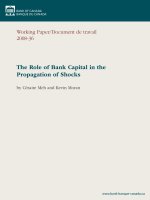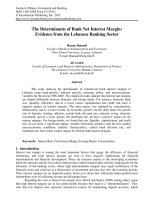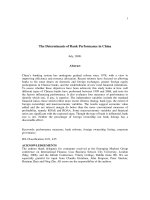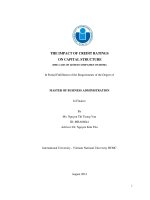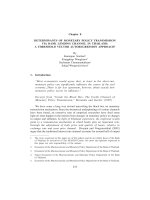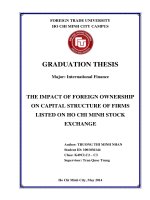Determinants of bank capital structure the case of vietnamnese commercial bank system
Bạn đang xem bản rút gọn của tài liệu. Xem và tải ngay bản đầy đủ của tài liệu tại đây (2.17 MB, 77 trang )
INSTITUTE OF SOCIAL STUDIES
THE HAGUE
THE NETHERLANDS
UNIVERSITY OF ECONOMICS
HO CHI MINH CITY
VIETNAM
VIETNAM- NETHERLANDS
PROGRAMME FOR M.A IN DEVELOPMENT ECONOMICS
DETERMINANTS OF BANK CAPITAL
STRUCTURE: THE CASE OF VIETNAMESE
COMMERCIAL BANK SYSTEM
BY
PHAM TUAN ANH
MASTER OF ARTS IN DEVELOPMENT ECONOMICS
HO CHI MINH CITY, JANUARY 2013
UNIVERSITY OF ECONOMICS
INSTITUTE OF SOCIAL STUDIES
HO CHI MINH CITY
THE HAGUE
VIETNAM
THE NETHERLANDS
VIETNAM- NETHERLANDS
PROGRAMME FOR M.A IN DEVELOPMENT ECONOMICS
DETERMINANTS OF BANK CAPITAL
STRUCTURE: THE CASE OF VIETNAMESE
COMMERCIAL BANK SYSTEM
A thesis submitted in partial fulfilment of the requirements for the degree of
MASTER OF ARTS IN DEVELOPMENT ECONOMICS
By:
PHAM TUAN ANH
Academic Supervisor:
DR. CAO HAO THI
HO CHI MINH CITY, JANUARY 2013
------
- - - - - - - - - - - - - - - - - - - - - - - -
ACKNOWLEDGEMENT
I am grateful to all those who help me to complete the thesis. I would like to thank
the Vietnam-the Netherlands Programme for giving me permission to carry out the
thesis after Thesis Research Design (TRD) defense and providing many precious
researches through an account ofEUR library website and others.
Especially, I am deeply thankful to my supervisor Dr. Cao Hao Thi from Industrial
Management Department of Ho Chi Minh City University of Technology for his
instructions, suggestions and encouragements during the implementation of the
thesis.
Moreover, I would like to express my deep gratitude to my family, friends and
colleagues for all their support and valuable hints in order to help me to complete
the thesis.
1
ABSTRACT
The study aims to identify determinants of Vietnamese banking capital structure.
.-
Using panel data analysis like Fixed Effects Method (FEM) and Random Effects
Method (REM), the study investigates the effect of size, growth, collateral value,
profitability, dividend policy and business risk determinants to capital structure of
commercial banks in Vietnam from 2007 to 20 11. The main findings of the study
are that Fixed Effects Model (FEM) is the most appropriate model in explaining the
banking capital structure; furthermore, size, growth, collateral and profitability
variables are statistically significant and have the expected sign with the book
leverage variable. However, risk and dividend variables are not statistically
significant.
Based on reality situations, it is widely believed that the capital structure of
Vietnamese banking system is not really good and does not meet the international
standard at present. The system does not have enough equity so as to prevent risks
from the negative externalities and unexpected change of business environment.
Therefore, the study is going to recommend some policy implications to improve
the capital structure situation by adjusting the determinants. Moreover, the study
also makes valuable instructions to banking managers of each commercial bank.
According to specific reality situation of each commercial bank, they will have right
decisions to increase or decrease book leverage so as to not only maximize the own
commercial bank's value but also avoid facing up bankruptcy events.
Keywords: capital structure, book leverage, commercial bank, Fixed Effects
Method (FEM), Random Effects Method (REM).
11
TABLE OF CONTENTS
Acknowledgement..............................................................................................
i
Abstract...............................................................................................................
ii
Table of Contents...............................................................................................
iii
Abbreviation....................................................................................................... vi
List of Table ........................................................................................................ vii
...
. 0 fF'Igure •••••••••••••••••••••••••••••••••••••••••••••••••••••••••••••••••••••••••••••••••••••••••••••••••••••• VIII
L 1St
CHAPTER 1. INTRODUCTION.....................................................................
1
1.1. Problem Statement........................................................................................
1
1.2. Research Objectives......................................................................................
6
1.3. Research Questions.......................................................................................
6
1.3.1. Main question.....................................................................................
6
1.3 .2. Sub questions .. ............. ..... ...... ........... .. .. .. ...... .. ...... ..... ............ ............
7
1.4. Justifications ofthe study .............................................................................
7
1.5. Scope of the study.........................................................................................
7
1.6. Organization ofthe study..............................................................................
8
CHAPTER 2. LITERATURE REVIEW.........................................................
9
2.1. Theoretical literature.....................................................................................
9
2.1.1. Modigliani and Miller (M&M theory, 1958).....................................
9
2.1.2. Agency theory.................................................................................... 10
2.1.3. The pecking- order theory................................................................ 11
2.1.4. The static trade-offtheory.................................................................. 12
111
2.2. Empirical literature ....................................................................................... 12
2.2.1. Foreign empirical literature ................................................................ 12
2.2.2. Vietnamese empirica1literature .......................................................... 22
2.3. Research Hypothesis ..................................................................................... 27
2.4. Conceptual Framework ................................................................................. 27
2.5. Chapter Summary ......................................................................................... 28
CHAPTER 3. DATA AND RESEARCH METHODOLOGY ...................... 29
3 .1. Research Methodology ................................................................................. 29
3.2. Data ............................................................................................................... 35
3.3. Chapter Summary ......................................................................................... 37
CHAPTER 4. FINDINGS AND DISCUSSION .............................................. 38
4.1. Descriptive Statistics ..................................................................................... 38
4.2. Panel regressions results ............................................................................... 41
4.3. Comparison with previous studies ................................................................ 48
4.4. Chapter Summary ......................................................................................... 50
CHAPTER 5. CONCLUSIONS AND POLICY IMPLICATIONS .............. 51
5 .1. Conclusions................................................................................................... 51
5.2. Policy Implications ....................................................................................... 52
5.2.1. Policy implications for total Vietnamese banking system .................. 52
5.2.2. Policy implications for specific Vietnamese commercial banks
cases .................................................................................................... 55
5.2.2.1. Policy implications for high leverage commercial banks ...... 55
5.2.2.2. Policy implications for low leverage commercial banks ....... 56
lV
5.3. Limitations and Further Studies .................................................................... 57
5.3.1. Limitations .......................................................................................... 57
5.3.2. Further Studies .................................................................................... 58
References........................................................................................................... 59
Appendices.......................................................................................................... 63
v
-----------
ABBREVIATION
BCBS: Basel Committee on Banking Supervision
BL: Book Leverage
CAR: Capital Adequacy Ratio
FEM: Fixed Effects Method
GDP: Gross Domestic Product
GMM: Generalized Method of Moments
REM: Random Effects Method
Vl
LIST OF TABLE
Table 1.1. Quantity of commercial banks in Vietnam........................................
•
3
Table 2.1. Definition ofVariables ....................................................................... 15
Table 2.2. Foreign empirical studies in researching the bank capital structure.. 20
Table 2.3. Empirical studies in researching the Vietnamese capital structure.... 25
Table 3.1. Definition ofVariables ....................................................................... 31
Table 3.2. Classifying banks in the sample by certain asset level on
December 31, 2011 ............................................................................ 36
Table 3.3. Financial items of the sample and total Vietnamese banking system
on December 31, 2011 ....................................................................... 36
Table 4.1. Summary statistics of each variable ................................................... 38
•
Table 4.2. Correlation matrix.............................................................................. 40
Table 4.3. FEM and REM regression results ...................................................... 42
Table 4.4. Hausman test ...................................................................................... 43
Table 4.5. Likelihood ratio test ........... ................................................................ 44
Table 4.6. Summary of research results ......... ................................... .............. .... 50
vii
LIST OF FIGURE
Figure 1.1. Capital Adequacy Ratio (CAR) of developing countries................. 5
Figure 2.1. The determinants of bank capital structure ...................................... 28
Figure 3.1. Research process of the study ........................................................... 29
Figure 4.1. Total asset in the sample from 2006 to 2011. ................................... 39
Figure 4.2. Total charter capital in the sample from 2006 to 2011 .................... 47
Vlll
CHAPTER 1. INTRODUCTION
1.1. Problem Statement
Based on Ross, Westerfield and Jaffe (2010), capital structure is the combination of
debt and equity. Each company should choose the suitable debt-equity ratio (capital
structure) in order to maximize the value of its company. When the capital structure
problems are mentioned in any researches, it is certainly that the famous theory
Modigliani and Miller (M&M theory, 1958) are applied in these researches.
According to M&M theory, in the perfect capital markets (case 1 of M&M
proposition 1), choosing any capital structure do not affect the value of specific
company. However, if all assumptions in M&M proposition 1 are held except taxes
and costs of financial distress, the value of the specific company will be affected by
choosing the capital structure because of the tax shield benefits and costs of
financial distress. After the capital structure theory of Modigliani and Miller, many
theories about capital structure are in tum released; in particular, agency theory was
created by Jensen and Meckling (1976); pecking - order theory and static trade-off
theory was developed by Myers (1984). These theories have indicated that capital
structure affects not only the value of each enterprise but also the stability in
business. Therefore, there have many authors who research about the capital
structure. They also try to find out the independent variables that affect the
enterprises capital structure; from that point, each enterprise have ability to choose
the appropriate capital structure in order to maximize the value of the firm and
stabilize the business operations.
Capital structure of each company is usually measured by the book leverage. It is
the basic formulation. It is calculated by debt-to-equity or debt-to-asset, with asset
is equity plus debt. Commercial banks access the primary debts by attracting the
money from depositors. The specific characteristic of commercial bank business is
to trade in money; thus, equity of commercial banks always accounts for small
proportion of total asset. Moreover, in the banking industry, they also use Capital
Adequacy Ratio (CAR), which is the other proxy to measure the capital structure of
1
each commercial bank (Basel Committee on Banking Supervision, 2006). CAR has
been mentioned in Basel Accords, which are issued by Basel Committee on
Banking Supervision (BCBS). Basel Accords have been built and developed in
order to control the risk from the banking system and prevent the collapse of
commercial banks in reality. CAR is calculated by equity over asset; however,
unlike book leverage, CAR emphasizes the different risk level of each asset. In
general, if commercial banks have low book leverage or high CAR, then they have
not ability to take full advantage of tax shield benefit. Conversely, if commercial
banks have high book leverage or low CAR, then they have to face up the high
financial distress cost such as the bankruptcy cost.
Vietnam is still a developing country. Since Doi Moi (economic reforms in 1986),
Vietnamese economy has changed from planned-economy into socialism-oriented
market economy. The financial sector, especially commercial bank system still have
a rapid development both quality and quantity. The quantity of Vietnamese
commercial bank system increases from 9 in 1991 to 94 in 2009. This leads to the
increase in competitive level of Vietnamese banking system. With the high
competitive level in Vietnamese commercial bank system at present, each bank has
to perform the right policy to maximize the value and reduce the business risk.
Among them, they need to choose the appropriate capital structure in order to carry
out the purpose. Table 1.1 presents quantity of commercial banks in Vietnam from
1991 to 2009.
2
----
-
-
------------------
Table 1.1: Quantity of commercial banks in Vietnam
1991
1995
1999
2003
2007
2008
. 2009
SOCBs
4
4
5
5
5
4
3
JSCBs
4
48
48
37
34
39
40
JVCBs
1
4
4
4
5
5
5
FCBs
0
18
26
27
41
44
46
Total
9
74
83
73
85
92
94
Year
Source: State Bank of Vietnam- SBV
(!Y_ote: SOCBs: State - Owned Commercial Banks; JSCBs: Joint - Stock Commercial
Banks; JVCBs: Joint - Venture Commercial Banks; FCBs: 100% Foreign-Owned
Commercial Banks and Branch of Foreign Commercial Banks)
..
The Vietnamese banking system has a rapid development; in addition, it contributes
to economic growth and living standard improvement. However, it has been
exposed many weaknesses and shortcomings; from that point, they have caused the
unsafe banking operations and unstable macroeconomic situation. Therefore, the
Government and State Bank of Vietnam have advocated restructuring the
Vietnamese commercial bank system by approving the project, which is namely
"Orientations and Policies to Restructure Vietnamese Banking System in 201120 15". Based on the project, the State Bank of Vietnam has recognized weaknesses
and shortcomings of Vietnamese banking system. Among them, the financial
capacity of Vietnamese banking system is still limited. According to the
14112006/ND-CP decree that was signed by Vietnamese Prime Minister on
November 22, 2006, each commercial bank has to meet the legal capital
"
requirement, minimum 3.000 billion VND in the end of 2010. However, based on
the information from the project, there have 3 commercial banks that do not meet
3
the requirement to 2011 yet; moreover, there are 30 commercial banks whose
charter capital are smaller than 5.000 billion VND (equivalent 240 million USD) in
the end of 20 11.
•
Moreover, Vietnamese commercial bank system is collapsed easily from the
negative externalities and unexpected change of business environment such as
global financial crisis in 2009 and unstable macroeconomic situation of Vietnam in
2011 because the capital structure of Vietnamese banking system does not meet the
international standard. Based on the information from the project, the average CAR
of Vietnamese commercial bank system was 11.85% at September 30, 2011,
especially the average CAR of State-Owned Commercial Banks was only 8.49%.
Meanwhile, the average CAR of Foreign-Owned Commercial Banks is very high
(28.58%). If the Foreign-Owned Commercial Banks was excluded from the
Vietnamese commercial bank system, then the real average CAR of domestic
commercial banks was only 11.13%. The Financial Management and Analysis of
Projects, issued by Asian Development Bank (ADB) in 2005, has recommended
that the minimum CAR of Asian Development Bank's Developing Member
Countries (ADB DMCs) should be 12% because of loose banking regulations and
supervisions, the expansion of directed lending. It is realized that the CAR of many
commercial banks does not meet the ADB standard, especially State-Owned
Commercial Banks. Besides, in reality, CAR of Vietnamese banking system is
much lower than many other developing countries. Other countries which are in the
Southeast Asia with Vietnam such as Indonesia, Philippines, Malaysia and Thailand
have the safe commercial bank system, with the CAR are very high and meet the
international standard well. Figure 1.1 compares the CAR of Vietnam in 2011 with
the one of other developing countries.
4
CAR
10.0%
5.0%
0.0%
Figure 1.1: Capital Adequacy Ratio (CAR) of developing countries
Source: State Bank ofVietnam-SBV
In short, the capital structure of Vietnamese banking system is not really good at
present. The system does not have enough equity in order to prevent risks from the
negative externalities and unexpected change of business environment. Therefore,
the capital structure problem needs to be solved seriously. The study desires to find
determinants of bank capital structure in Vietnam; thus, they will be controlled
logically in order to improve the Vietnamese banking capital structure.
Moreover, according to the static trade-off (Myers, 1984), each Vietnamese
commercial bank need to choose the own appropriate capital structure by
considering the trade-off between the benefit of debts and cost of debts. The benefit
of debts is the tax deductibility of interest payments and the cost of debts is the cost
of financial distress such as bankruptcy cost and the losses that the firm has to incur
from the bankruptcy events. In reality, it is difficult to choose the optimal capital
structure because Vietnamese commercial banks almost have not ability to identify
the cost of financial distress. Therefore, managers of each Vietnamese commercial
bank only have ability to identify the range of own appropriate leverage in order to
5
not only maximize the own commercial bank's value but also avoid facing up the
bankruptcy events. The study has no ambition to find the optimal capital structure
of Vietnamese commercial bank system, but merely to identify its determinants;
thus, banking managers have ability to control these determinants in order to gain
the own leverage that is suitable for the business of each commercial bank.
According to the previous research such as Octavia, M. & Brown, R. (2008), Gropp,
R. & Heider, F. (2009), Caglayan, E. & Sak, N. (2010) and Chau, N.H (2012), it is
widely believed that the capital structure of commercial banks are affected by size,
profitability, business risk, growth, collateral value and dividend policy. Therefore,
the study tests whether these factors as above are really impacting on capital
structure in Vietnamese commercial bank system.
1.2. Research Objectives
The objectives of this study are to:
i) Determine the elements which have impacted on capital structure of Vietnamese
commercial bank system and test whether each element causes capital structure of
Vietnamese commercial bank system.
ii) Recommend some policy implications m order to not only develop the
commercial bank system but also control the risk from their business; in addition,
the study desires to make valuable instructions to improve the capital structure of
each Vietnamese commercial bank by controlling the determinants.
1.3. Research Questions
1.3.1. Main question
The main question of the study is "What are the determinants of capital structure in
Vietnamese commercial bank system?"
6
----------------
-- - - -
1.3.2. Sub questions
i) Do factors like size, growth, collateral value, profitability, business risk and
dividend policy have statistically significant in explaining the model that related
with capital structure of commercial banks in Vietnam?
ii) Do these factors as above have the expected sign in accordance with capital
structure theories and previous studies?
1.4. Justifications of the study
There have many empirical studies that related to the capital structure problem;
however, there have few empirical studies which research the determinants of bank
capital structure. Moreover, most of the studies focus on the situation of Europe and
USA. Therefore, this paper contributes to the academic study as one of
comprehensive studies about the capital structure of commercial banks in Vietnam.
In addition, this study aims to update the hottest issues of the capital structure of
Vietnamese commercial bank system. The study analyzes capital structure problem
in the background of restructuring banking system process of Vietnamese
Government and State Bank of Vietnam. According to the useful and informative
results, authorities have ability to propose the right policies to develop the
commercial bank system and control the risk from their business; besides, managers
of each Vietnamese commercial bank have ability to choose the own appropriate
capital structure.
1.5. Scope of the study
The study determines the elements which have impacted on bank capital structure in
Vietnam from 2007 to 20 11.
7
1.6. Organization of the study
The remaining study includes 4 chapters: Chapter 2 gives a review of theoretical
and empirical studies which are related to capital structure topic. Chapter 3
mentions the research methodology and data collection; thus, findings and
discussion are presented in Chapter 4. Finally, Chapter 5 draws conclusions,
recommends some policy implications and mentions limitation; thus, some
directions for further studies are also presented in the chapter.
8
---------------
---
CHAPTER 2. LITERATURE REVIEW
Chapter 2 gives a review of theoretical and empirical studies which are related to
capital structure topic. The chapter presents 4 main parts which contain theoretical
literature, empirical literature, research hypothesis and conceptual framework. First,
theoretical literature part introduces 4 famous theories which include Modigliani
and Miller (M&M theory, 1958), agency theory (Jensen and Meckling, 1976),
pecking - order theory and static trade-off theory (Myers, 1984). Second, empirical
literature part presents cases of developed and developing countries which are
related to both non-bank and bank capital structure. Thus, research hypothesis and
conceptual framework will be mentioned in the study based on the results of
previous empirical studies.
2.1. Theoretical literature
When mentioning the capital structure, there are several theories that are related to
•
this issue. Among them, the first cornerstone of capital structure theories has been
carried out by Modigliani and Miller (M&M theory, 1958). After the capital
structure theory of Modigliani and Miller, many theories about capital structure are
in tum released. The study expresses 3 famous other capital structure theories,
which include agency theory was created by Jensen and Meckling (1976); peckingorder and static trade-off theory was developed by Myers (1984).
2.1.1. Modigliani and Miller (M&M theory, 1958)
According to the M&M theory, there are 2 basic propositions: proportion 1
examines the relationship between the firm value (V) and capital structure and
proportion 2 investigates the relationship between cost of capital (r5) and capital
structure. In each proportion, authors considered 3 specific cases. In my topic, the
proportion 1 ofM&M theory is researched deeply.
In case 1 of the proportion 1, all assumptions hold in this model: homogeneous
expectations, homogeneous business risk classes, perpetual cash flows, and
9
especially, capital market is perfectly; it means that there exists perfect competition,
firms and investors have ability to borrow or lend at the same interest rate and they
equally access to all relevant information. Moreover, there have no financial distress
costs and taxes. Besides, Modigliani and Miller also mentioned other cases, in
particular, all assumptions as above hold except the corporate income tax
assumption (case 2) and all assumptions as above hold except the corporate income
tax and financial distress costs assumptions (case 3).
Based on the M&M theory, the value of unlevered firm and levered firm are the
same in case 1, it means that choosing any capital structure do not affect the value
of the firm. However, in case 2 and 3, the value of the firm is affected by the capital
structure, in particular, the functions as below show the relationship between the
value of the firm and capital structure:
Case 1: VL = Vu
Case 2: V L = Vu + Tc * B
Case 3 : VL = Vu + Tc * B - PV(costs of financial distress)
With VL: value of the levered firm; Vu: value of the unlevered firm; B: debt value;
Tc: rate of corporate tax, Tc
*
B: present value of tax shield and PV(costs of
financial distress) is the present value of financial distress cost.
Especially, in case 3, the value of the firm rises with leverage and falls with costs of
financial distress. Therefore, each firm should choose the appropriate capital
structure in order to take advantages of tax shield benefits; however, if the leverage
of the firms is too high, then they will face up the high costs of financial distress
such as bankruptcy cost. The possibility of bankruptcy has a negative impact on the
value of the firm.
2.1.2. Agency theory
Jensen and Meckling (1976) proposed that the firm may choose capital structure
according to the existence of agency cost. There are 2 main conflicts in choosing the
10
capital structure. First, the conflicts between managers and shareholders will happen
since managers desire to receive more benefits but doing less effort in maximizing
the value of the company. Therefore, managers decide to increase the level of the
debts so as to carry out the high risky projects. The purpose of decisions is to
complete the tasks and business plan from the requirements of stockholders;
however, if these projects face up losses, then stockholders will bear the
consequences of losses. Second, rising level of debts may arise the conflicts
between shareholders and debt-holders. Debt-holders always receive the fixed
return. The conflicts arise when the shareholders decide to perform the high risky
projects. If the investments earn the return that higher than the value of debts, then
shareholders will receive most of the gain; otherwise, the debt-holders have to incur
the losses because the maximum losses of stockholders are only the amount of their
initial stockholders' investment (limited liabilities).
2.1.3. The pecking-order theory
The pecking-order theory was developed by Myers (1984). He argued that the
capital structure choice of the firm can be explained from the perspective of
asymmetric information and the existence of transaction costs. The more level of
asymmetric information, the more risk that outsider investors facing; thus, the
outsider investors require more discount rate from issuing stocks. Therefore, the
preference of the firm is that they would like finance by internal funds first such as
retained earnings, instead of with external funds. If the firm must to attract the
external funds, then debt is preferred to equity.
The theory has explained that companies usually use less debt when they have
ability to earn the high return because they prioritized to finance their projects by
internal funds. Besides, the theory has also appreciated the importance of financial
slack. When enterprises have the financial slack, they have spare cash or transfer the
asset such as government bond, stock ... into cash easily. From that point, they have
ability to take advantage of investment opportunities as they appear. On the
11
- - - - - - - - -
contrary, if enterprises have no financial slack, then they have to choose the external
funds by borrowing debts with high interest rate or issuing the common stock that
price of each stock is under the face value.
2.1.4. The static trade-off theory
The static trade-off theory was also developed by Myers (1984 ). This theory
suggests that each firm need to choose the appropriate capital structure by
considering the trade-off between the benefit of debts and cost of debts carefully.
The benefit of debts is the tax deductibility of interest payments and the cost of
debts is the cost of financial distress such as bankruptcy cost and the losses that the
firm has to incur from the bankruptcy events. However, in reality, it is difficult to
choose the optimal capital structure because the firms almost have not ability to
determine the cost of financial distress.
In general, commercial bank is the special kind of enterprises so M&M, agency,
pecking-order and static trade-off theories are absolutely applied for choosing the
appropriate bank capital structure.
2.2. Empirical literature
2.2.1. Foreign empirical literature
There have many empirical studies which research about the capital structure.
However, almost empirical studies specialize in researching non-banks capital
structure. Booth
et al. (200 1), Frank and Goyal (2005) argue that several
independent variables which may affect the leverage of each non- financial
institution are size, profitability, business risk, growth, collateral value and dividend
policy.
First, size has the positive relationship with the leverage. Large firms normally
finance their projects by using more debts. They are difficult to cope with the
bankruptcy because of higher diversification. The positive relationship between size
12
-
.
--- --- -------
and leverage has been in accordance with the argument of asymmetric information
(Myers and Majluf, 1984). Small enterprises usually do not announce enough
information about their financial situation or extraordinary events; accordingly,
potential lenders are afraid of providing credit fund to small-size enterprises. On the
contrary, large firms, especially listed firms, are easy to access loans from financial
institutions because there have a little asymmetric information between the owners
and creditors. The firms have ability to make the best of economies of scale in
accessing long-term loans or issuing long-term debts such as corporate bonds;
moreover, they may have bargaining power to lenders.
Second, firms with higher profit tend to have lower debt-equity ratio. It has been
suitable for the viewpoint of the pecking-order theory (Myers, 1984). High-profit
companies usually finance its project by retained earning first, instead of with
external fund because of the perspective of asymmetric information and the
existence of transaction costs.
Third, there is negative relationship between the business risk and leverage. Frank
and Goyal (2005) argued that firms face up high business risk when they have more
volatile cash flow; thus, they cope with the higher cost of financial distress. They
have considered the trade-off between tax-shield benefits and bankruptcy cost.
More financial distress cost decreases the probability that tax-shield benefits will be
used up; as a result, they should use less debt in order to reduce the volatile cash
flow.
Fourth, firm's growth has the negative relationship with the leverage. Booth et al.
(200 1), Frank and Goyal (2005) both use market-to-book ratio as a proxy for
growth. A high market-to-book ratio means that firms have ability to carry out the
high growth opportunities; however, these firms also face up the higher cost of
bankruptcy. Therefore, companies which have high market-to-book ratio tend to use
less leverage. Besides, Frank and Goyal (2005) also have recommended that the
growth of assets and ratio between capital expenditures and assets are the other
13
proxies to measure the firm's growth. They have argued that these variables should
be positively with the book leverage according to the viewpoint of the pecking order theory. When profits do not increase correlatively with the increase in
investment activities of firms, then they should use more debt in order to keep the
high growth.
Fifth, if companies have many tangible assets, then they will use more debts
because these assets can be used as collateral. The agency theory has explained the
relationship clearly. Jensen and Meckling (1976) have emphasized that there always
exist agency cost of debts. The conflicts arise when the shareholders decide to carry
out the high risky projects. If the investments earn the return that lower than the
value of the debts, the debt-holders have to incur the losses. Therefore, debt-holders
are willing to lend more money and reduce the credit risk when firms have many
tangible assets that can be used as collateral. Furthermore, based on the static tradeoff theory (Myers, 1984), tangible assets such as land, equipments, factories ... have
lower expected financial distress cost; on the contrary, intangible assets will lose
most their value if bankruptcy event occurs.
Finally, when firms have ability to pay dividend, then they will use less debts.
Based on the pecking-order theory (Myers and Majluf, 1984 ), dividend is
considered as good signal about future prospect of firms; accordingly, they will
issue more equity and less leverage.
According to Mishkin (2000), capital structure of commercial banks may be
affected only by the regulations of capital requirement, especially each commercial
bank must reserve amount of capital to reduce the probability of failure according to
the standard of Basel Accords. However, several empirical studies like Octavia, M.
and Brown, R. (2008), Gropp, R. and Heider, F. (2009), Caglayan, E. & Sak, N.
(2010) found that standard determinants of non-firm capital structure which include
size, profitability, business risk, growth, collateral value and dividend policy are
also significant in explaining the capital structure of banks. The dependent variables
14
. - - - -- - - - - - - - - - - -
of the 3 empirical studies, which was considered as the proxy of commercial bank
capital structure, was the book leverage or market leverage. It is measured by debtto-equity or debt-to-asset, with asset is equity plus debt. In banking industry,
commercial banks access primary debts by attracting the money from depositors.
These studies used fixed effect of panel data method to identify determinants of
bank capital structure. Octavia, M. and Brown, R. (2008), Gropp, R. and Heider, F.
(2009) have shown that book leverage has been affected by 6 main determinants,
which include size, profitability, growth, collateral value, dividend policy and asset
risk. Table 2.1 presents ways to measure each variable in Octavia, M. and Brown,
R. (2008), Gropp, R. and Heider, F. (2009) and Caglayan, E. & Sak, N. (20 10).
Table 2.1: Definition of Variables
No.
Variables
Measure
A. DEPENDENT VARIABLES
1 Book Leverage (BL)
1-(book value of equity I book value of assets)
2 Market Leverage (ML)
1-(market value of equity I market value of assets)
B. INDEPENDENT VARIABLES
1 Size
book value of assets
2 Profitability (Prof)
Profit after tax I book value of assets
3 Market-to-book ratio (MTB)
Market value of assets I Book value of assets
4 Collateral (Coli)
Tangible assets I book value of assets
5 Dividend (Div)
Equal1 when bank pays dividend in a given year
6 Asset risk (Risk)
Yearly standard deviation of daily stock price
returns
* (market value of equity I market value of
bank)
15


